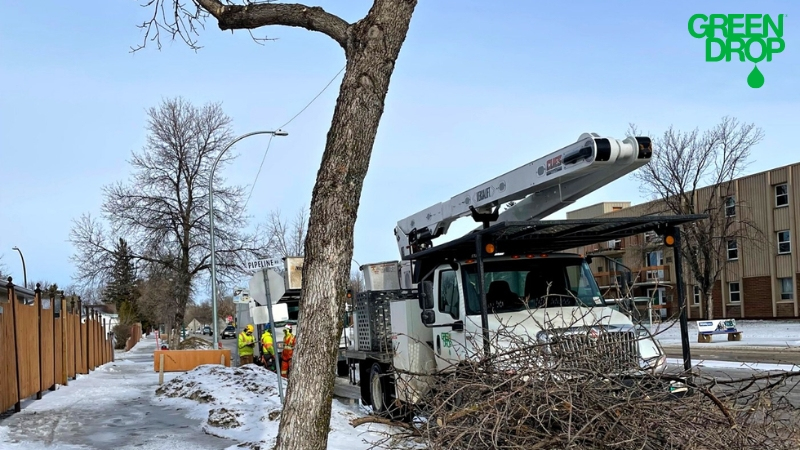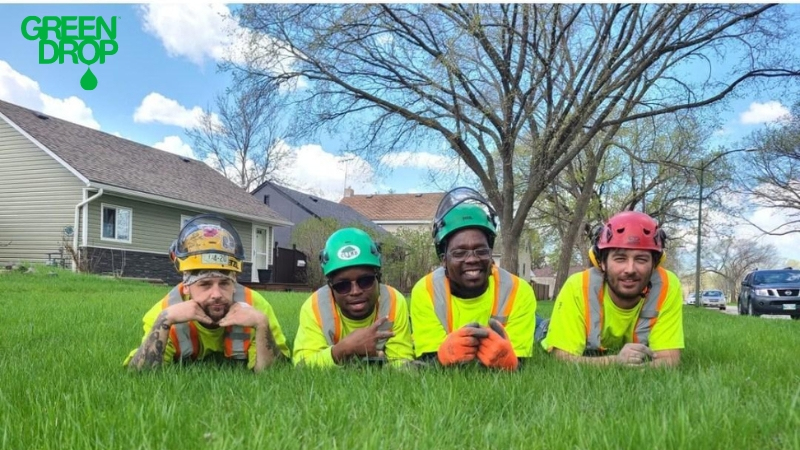Tree Care in Red Deer: What to Do When a Tree Starts to Tilt?
Reading time: 6 minutesIs a tree in your yard starting to lean as if it's trying to sneak away in the middle of the night? How could it, after all the love and care you’ve given it?
Tree tilting is more than just a quirky attitude problem—it’s more like a cry for help! Before you start planning a serious sit-down with your tree, take a breath and understand the why and how of this tilt.
Stick with us, and we’ll discover why trees start to tilt and how you can straighten things out (literally and figuratively).

Why Do Trees Tilt
Trees can start to tilt for various reasons, which often involve issues beneath the soil, environmental pressures, or internal health problems.
- Poorly Planted Trees: Trees planted too shallowly or without proper site preparation may not have a stable root base, making them more prone to tilting as they grow.
- Soil Type and Condition: Trees planted in too loose or sandy soils may not have sufficient support for their root systems, leading to instability and tilting.
- Root Rot: Fungal infections from overly moist soil conditions can cause roots to decay, weakening their hold on the earth.
- Soil Erosion: Heavy rain or improper drainage can wash away the soil around roots, reducing stability.
- Construction Damage: Nearby digging or construction can sever significant roots, destabilizing the tree.
- Root Competition: Trees planted too close together may compete for soil space, leading some to tilt as they reach for more resources.
- Strong Winds: Persistent or strong winds can push trees to one side, gradually causing them to lean.
- Heavy Snow Accumulation: The weight of snow on branches can pull trees down or to one side, especially if snow accumulation is uneven.
- Imbalanced Watering: Over or under-watering can lead to uneven soil moisture levels, causing some roots to weaken or die.
- Disease: Internal decay from diseases can weaken the trunk and branches, making them more susceptible to bending.
- Pest Infestations: Insects like borers can compromise the structural integrity of the tree by tunnelling through the trunk and branches.
- Improper Pruning: Incorrect or excessive pruning can disrupt a tree's natural balance, causing it to lean toward the more heavily branched side.
- Natural Growth Patterns: Some tree species have natural growth tendencies that include leaning, especially if they’re growing toward a light source or away from wind or shade.
- Age-Related Decline: Older trees may naturally start to lean due to cumulative stress and gradual weakening over time.
The Risks of Ignoring a Tilting Tree
If left unaddressed, a tilting tree poses significant risks to property and personal safety. It can unexpectedly fall, causing extensive damage to homes, vehicles, and other structures. The potential for crushing roofs, breaking windows, or destroying fences can lead to costly repairs and a complicated claims process with insurance companies, and we obviously want to avoid that.
This risk is particularly high during adverse weather conditions like high winds or storms, which can push an already unstable tree past its breaking point.
Even if you feel that your tree’s tilt isn’t too bad right now, you can’t ignore it. Tilting is often a sign that the tree is suffering from underlying health issues that can progressively worsen if ignored. Without timely intervention, the tree could lose its ability to recover, leading to irreversible decline and eventual death. Addressing this issue swiftly can prevent the complete loss of the tree and ensure safety for all.

When to Call an Arborist
It’s best to call an arborist as soon as you notice your tree starting to tilt, especially if the tilt poses immediate risks or the cause is not straightforward. Our ISA-certified arborists bring a level of expertise crucial for accurately diagnosing and resolving issues that might not be apparent to you.
How Our Arborists Address Tilting Trees
Initial Assessment and Diagnosis
Our arborists are ISA Tree Risk Assessment Qualified. That means they’re trained to use systematic methods to identify minor signs and symptoms of tree responses to internal decay and cracks that may not be identifiable by arborists without this specialized training.
We begin with a thorough inspection to determine why the tree is tilting. This includes examining the tree's overall health, checking for signs of disease or pest infestation, and assessing the stability and condition of the root system. Our team utilizes state-of-the-art equipment, such as a resistograph to assess internal decay and drones to detect pest and disease patterns in the air.
We understand that precise treatment relies on accurate pest and disease identification. Our internal laboratory and ISA Board Certified Master Arborists assist our arborists in identifying pests and diseases that are not easily identified in the field.
We also consider environmental factors such as recent weather events or changes in the surrounding landscape that might have contributed to the problem. This comprehensive evaluation helps determine the viability of saving your tree and the best approach to take.
Corrective Actions and Treatments
Depending on the diagnosis, our arborist might recommend several interventions:
- Staking and Guying: This is used for younger or smaller trees that need temporary support to realign and stabilize.
- Cabling and Bracing: For larger trees, these techniques are used to redistribute weight and enhance structural support, preventing further tilting or potential collapse.
- Root Pruning: This is sometimes necessary to remove damaged or diseased roots and encourage the growth of new, healthy roots.
- Partial Removals: In cases where certain branches or sections of the tree contribute to instability, we feel that selective pruning or removal are good options.
- Root Barriers: This involves installing root barriers to direct root growth away from unstable areas or structures that could be causing uneven root development.
- Installing Support Posts: In some scenarios, installing support posts can offer a more permanent solution to support a tree till it can sustain itself.
- Transplanting: If a tree is young and small enough and the location is inappropriate due to environmental conditions, we might recommend relocating the tree to a more suitable location.
Preventative Measures
Beyond immediate corrections, we also want to focus on preventive measures to ensure long-term tree health and stability. This would involve:
- Strategic Pruning: Regular pruning manages the tree’s weight and shape and reduces stress on the root system and trunk.
- Improving Soil Conditions: Enhancing soil quality through aeration and the addition of organic matter can help support a robust root system.
- Monitoring and Maintenance: Ongoing inspections and care will monitor the tree’s recovery and prevent future issues.
- Adjusting Watering Practices: Optimising irrigation practices to ensure even soil moisture levels can help prevent differential soil settlement that may cause tilting.
Let Your Tree Lean on Our Awesome Team of Arborists

It’s clear that when your tree starts leaning, the clock starts ticking on potential risks. We need timely intervention. Don’t wait for the tilt to turn into a fall! If you notice your tree starting to lean, call in the experts.
Get a free estimate and let our arborists assess the situation and provide the necessary care. Our tree health care services are led by a team of seasoned, ISA-certified arborists whose expertise ensures the health and safety of your treasured trees.
Let’s get your tree back on the straight and narrow today! We provide a range of tree care services in most of Western Canada, from Red Deer to Calgary, Winnipeg, Regina, Saskatoon, and Edmonton.

